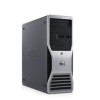Dell Precision 490 Desktop User's Guide - Page 16
Onboard Devices, Video
 |
View all Dell Precision 490 Desktop manuals
Add to My Manuals
Save this manual to your list of manuals |
Page 16 highlights
(On default) NOTE: Drive 4 can be enabled or disabled when SATA Operation is set to RAID Autodetect/AHCI. In other modes, this field might be non-functional. In this case, the text in the Drive 4 field reads as follows: Drives 5 through 6 This SATA port is disabled because the system has been configured for ATA mode. Enables or disables a PATA device (such as a CD or DVD drive). On enables the interface so that the device can be used. (On default) Displays the Controller type (ATA), Port number the drive is using, Drive ID number, Capacity, and whether the drive is controlled by the BIOS. SATA Operation (RAID Autodetect/ AHCI default) Determines the integrated SATA controller's operating mode. RAID Autodetect/ AHCI - RAID if the drives are signed, otherwise AHCI. RAID Autodetect/ ATA - RAID if the drives are signed, otherwise ATA. RAID On - SATA is configured for RAID on every boot. Combination - SATA/ PATA combination mode. Onboard Devices Integrated NIC (On default) Enables or disables the integrated NIC controller. Settings are On, Off, On w/RPL, or On w/ PXE. When the On w/ PXE or the On w/RPL setting is active, if a boot routine is not available from the network server, the computer attempts to boot from the next device in the boot sequence list. Integrated Audio (On default) Enables or disables the onboard audio controller. USB Controller Enables or disables the internal USB controller. No Boot enables the controller but disables the ability to boot from a USB device. (On default) Front USB Ports (On default) USB for Flexbay NOTE: Operating systems with USB support will recognize USB floppy drives regardless of the No Boot setting. Enables or disables the front USB ports. On enables internal USB for FlexBay. (On default) LPT Port Mode NOTE: This USB option appears only if a FlexBay device is installed. Determines the mode of operation of the internal parallel port. Off disables the port. AT configures the port for AT compatibility. PS/2 configures the port for PS/2 compatibility. EPP configures the port for the EPP bidirectional protocol. ECP configures the port for the ECP bidirectional protocol. (PS/2 default) LPT Port Address NOTE: If you set the LPT Port Mode to ECP, the LPT Port DMA appears in the option menu. Determines the address that the built-in parallel port uses. Serial Port #1 Determines how the serial port operates. (Auto default) Auto, the default setting, automatically configures a connector to a particular designation (COM1 or COM3). Serial Port #2 Determines how the serial port operates. (Auto default) Auto, the default setting, automatically configures a connector to a particular designation (COM2 or COM4). PS/2 Mouse Port (On default) Enables or disables the integrated legacy PS/2-compatible mouse controller. Video















